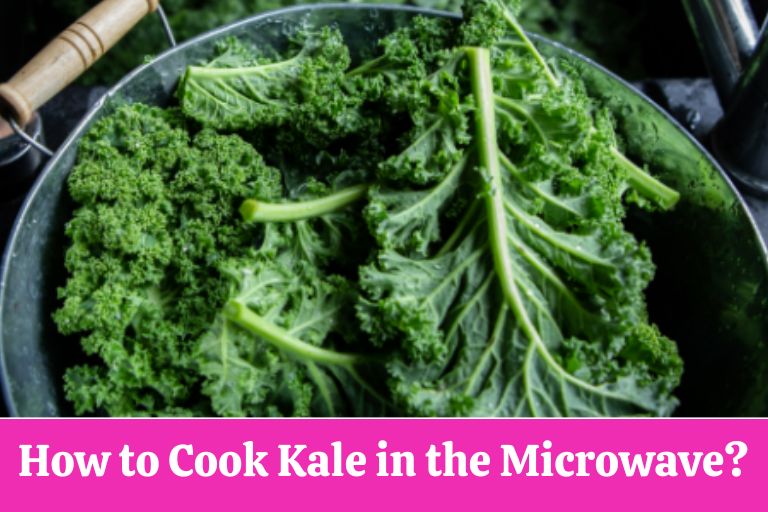Kale has soared in popularity in recent years, and for good reason. This leafy green is packed with vitamins, minerals, and antioxidants, making it a nutritious addition to any meal.
While you might be used to sautéing or steaming kale on the stovetop, there’s a quicker and easier way to enjoy this superfood – cooking it in the microwave.
In this guide, we’ll show you how to cook kale in the microwave, bringing out its vibrant flavor and preserving its nutritional benefits.
Why Choose the Microwave?
Cooking kale in the microwave offers several advantages that make it an attractive option for busy individuals or anyone looking for a speedy, healthy side dish:
1. Convenience:
Microwave cooking is incredibly convenient. It requires minimal prep work, and you can have a delicious bowl of kale ready in just a few minutes.
2. Speed:
Microwaves cook food quickly, making them perfect for those times when you need a nutritious meal in a hurry.
3. Nutrient Retention:
Contrary to popular belief, microwave cooking can help preserve the nutrients in kale better than some other cooking methods. The short cooking time and minimal water usage help prevent nutrient loss.
Now that you know why microwaving kale is a fantastic choice, let’s dive into the step-by-step process of how to do it.
Preparing Kale for Microwave Cooking
Step 1: Wash the Kale
Before cooking kale in the microwave, it’s essential to wash it thoroughly. Fill a bowl with cold water and immerse the kale leaves. Swish them around to remove any dirt or debris. Drain and repeat this process until the water runs clear.
Step 2: Remove the Stems
Kale stems can be tough and fibrous, so it’s best to remove them before cooking. Hold the stem end of a kale leaf with one hand and use your other hand to strip the leaves away from the stem. You can also use a knife to cut the leaves away from the stems.
Step 3: Chop or Tear the Kale
Once the stems are removed, chop or tear the kale into bite-sized pieces. Smaller pieces cook more evenly in the microwave, ensuring that every bite is tender and flavorful.
Choosing the Right Microwave-Safe Dish
For microwave cooking, it’s crucial to use microwave-safe containers. Glass and microwave-safe plastic containers work well. Avoid using metal or containers that are not labeled as microwave-safe, as they can cause fires or damage to your microwave.
Seasoning and Flavoring Options
One of the joys of cooking kale is the ability to infuse it with flavor. Here are some seasoning and flavoring options to consider:
- Olive Oil: Drizzle a bit of olive oil over the kale to add richness and help the seasonings adhere to the leaves.
- Garlic: Crushed garlic cloves or garlic powder can give your kale a delightful savory kick.
- Lemon Juice: A splash of fresh lemon juice can brighten up the flavor and balance the bitterness of kale.
- Red Pepper Flakes: If you like a little heat, sprinkle some red pepper flakes on your kale for a spicy twist.
Feel free to get creative with your seasonings and experiment with different combinations to find your favorite flavor profile.
Cooking Kale in the Microwave
Step 4: Place Kale in a Microwave-Safe Dish
Transfer the prepared kale to a microwave-safe dish. Make sure the dish is large enough to hold the kale without overcrowding it, as this can lead to uneven cooking.
Step 5: Season and Cover
Drizzle your chosen seasonings (e.g., olive oil, garlic, lemon juice, or red pepper flakes) over the kale. Toss the kale gently to ensure even coating. Then, cover the dish with a microwave-safe lid or microwave-safe plastic wrap. Covering the kale helps trap steam, ensuring it cooks evenly and retains moisture.
Step 6: Cook in the Microwave
Place the covered dish in the microwave and cook on high power for approximately 2-4 minutes. The exact cooking time will depend on your microwave’s wattage and the quantity of kale.
Start with 2 minutes, then check for doneness. If the kale is not yet tender, continue microwaving in 30-second intervals until it reaches your desired level of tenderness.
Checking for Doneness
Kale is ready when it’s tender but still slightly crisp. Be careful not to overcook it, as this can result in a mushy texture and a loss of flavor and nutrients. Here are a few tips for checking doneness:
- Use a fork or knife to pierce a piece of kale. It should go in easily.
- Taste a small piece to ensure it’s cooked to your liking.
- Keep in mind that kale will continue to cook a bit after you remove it from the microwave due to residual heat.
Serving Suggestions
Now that you’ve mastered the art of cooking kale in the microwave, it’s time to enjoy your creation. Here are some serving ideas to inspire you:
- As a side dish: Serve your microwave-cooked kale as a nutritious side alongside your favorite protein, such as grilled chicken or baked salmon.
- In a salad: Toss the cooked kale with other salad ingredients like cherry tomatoes, cucumber, and a flavorful dressing for a tasty and healthy salad.
- In a stir-fry: Add microwave-cooked kale to your favorite stir-fry for an extra boost of greens and nutrients.
- As a topping: Use it as a topping for pizza, flatbreads, or baked potatoes.
- In omelets or scrambled eggs: Mix it into your morning eggs for a nutritious and satisfying breakfast.
- In pasta dishes: Stir microwave-cooked kale into pasta dishes like spaghetti or fettuccine Alfredo for added texture and nutrients.
Kale’s versatility makes it a fantastic addition to a wide range of dishes, so don’t be afraid to get creative with how you incorporate it into your meals.
Health Benefits of Microwave-Cooked Kale
Beyond its convenience and delicious flavor, kale is a nutritional powerhouse that offers several health benefits:
1. Rich in Vitamins and Minerals:
Kale is loaded with essential vitamins and minerals, including vitamin K, vitamin A, vitamin C, calcium, and potassium.
2. High in Fiber:
Kale is an excellent source of dietary fiber, which supports digestive health and helps you feel full and satisfied.
3. Antioxidant-Rich:
Kale is packed with antioxidants, including beta-carotene and flavonoids, which help protect your cells from damage caused by free radicals.
4. Low in Calories:
Kale is a low-calorie food, making it a great addition to a weight-conscious diet.
5. Supports Heart Health:
The high levels of potassium and fiber in kale can help lower blood pressure and reduce the risk of heart disease.
6. May Reduce the Risk of Certain Diseases:
Kale’s antioxidant and anti-inflammatory properties have been linked to a reduced risk of chronic diseases, including cancer.
Microwave cooking can help preserve these valuable nutrients, making kale an even more nutritious addition to your diet.
Conclusion
Cooking kale in the microwave is a quick and convenient way to enjoy this nutritious leafy green. With the right preparation, seasoning, and cooking techniques, you can savor the flavors and reap the health benefits of kale in a matter of minutes.
Whether you’re adding it to salads, stir-fries, or enjoying it as a simple side dish, microwave-cooked kale can be a tasty and nutritious addition to your meals.
So, the next time you’re in a hurry but still want to eat healthily, give microwave-cooked kale a try – your taste buds and your body will thank you for it.




